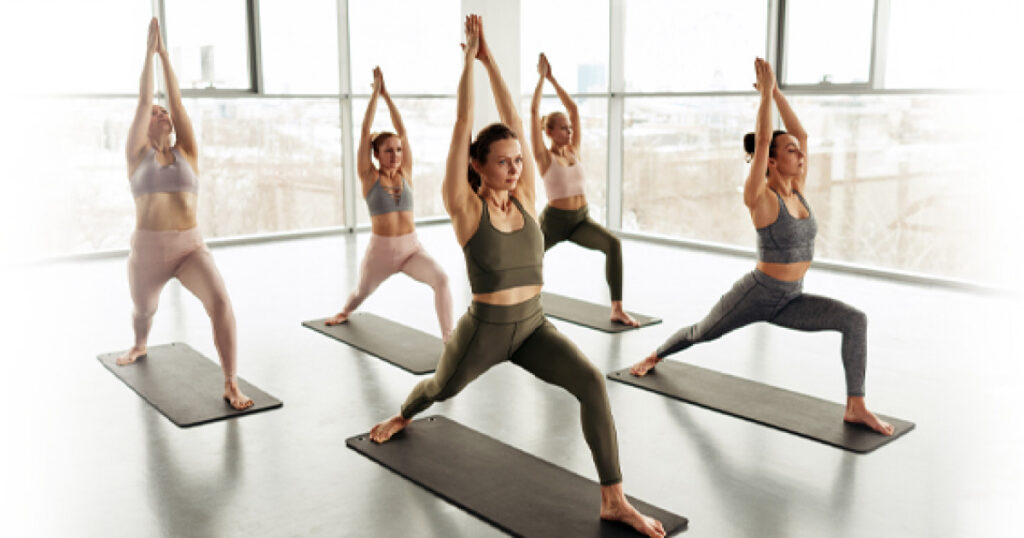When you hit 40, you may begin to experience signs of aging like lower metabolism and slower body movements. To combat these issues, try incorporating yoga into your daily routine!
If you’re new to yoga, consider starting slow and easing into more challenging poses. Here are some benefits of doing yoga that make it ideal for people over 40:
Improved Circulation
As you get older, it’s more important than ever to take a look at the state of your cardiovascular health. A sedentary lifestyle, an unhealthy diet, and a lack of aerobic exercise can all increase your risk for heart disease. The good news is that regular practice of yoga can help you avoid these problems and improve your cardiovascular system, according to several studies.
In addition to the physical benefits of a regular yoga practice, incorporating meditation and breathing exercises can improve your mental well-being, helping you to lower stress levels and anxiety. In turn, this can decrease your blood pressure and heart rate, further improving your circulation.
When you exercise, your body needs to circulate blood throughout the entire system to deliver oxygen to the cells and remove carbon dioxide waste. When it comes to treating erectile dysfunction (ED Pills Cenforce 120mg and Cenforce 150mg) or associated issues, yoga can offer a variety of advantages for both men and women. Yoga exercises, such as poses that force you to stretch and breathe deeply, stimulate the muscles of your lungs and diaphragm, which in turn improve your breathing and the way that you exhale carbon dioxide. This improved circulation in the lungs also promotes blood flow throughout the rest of the body.
Another benefit of yoga is that it can boost your heart health by keeping your blood sugar in check, reducing cortisol and adrenaline levels, encouraging weight loss, and improving insulin sensitivity. This can prevent diabetes complications such as kidney failure, blindness, and heart attacks. It can also improve balance, which can prevent falls that are common causes of fatal and nonfatal injuries among the elderly.
Moreover, a regular practice of yoga increases proprioception, or the ability to sense the position of your body in space. This can help you keep your balance better as you age, preventing fall-related injuries that often result in admission to a nursing home.
In a series of randomized controlled trials, researchers found that yoga can improve known predictors of frailty, including walking speed and the ability to rise from a chair. This is especially helpful for people over 40 when a decline in walking speed can be a warning sign of impending frailty.
Enhanced Flexibility
Yoga is a low-impact exercise that builds muscle strength, flexibility, and endurance. It also helps you manage your weight and reduces stress. It is a great exercise for older adults because it doesn’t require any special equipment, and many exercises can be done in a sitting position. However, it’s important to work with an experienced instructor who can modify poses for people with physical limitations.
Yoga improves your ability to listen to your body’s needs. As a result, you become more aware of your body’s desires and demands, which can help you avoid injuries. In addition, yoga requires you to focus your attention on a specific task, which can help you concentrate and maintain mental health.
Another benefit of yoga is that it can help you develop greater balance and flexibility. Developing better balance is especially important for seniors because it can help reduce the risk of falls. A study found that people who practiced yoga regularly had better balance and posture than those who didn’t.
There are several different types of yoga, and you should choose a type that is right for your needs. Bikram yoga is a popular form of yoga that is typically performed in a room that is heated to more than 100 degrees and has 40 percent humidity. This can cause you to sweat a lot, which is good for your muscles and skin, but it’s not a good idea for people with high blood pressure or heart problems.
Another type of yoga is Iyengar, which emphasizes proper alignment in all poses. This type of yoga is beneficial for people who have rheumatoid arthritis because it can help them deal with joint pain and stiffness. It can also help people with multiple sclerosis by increasing their range of motion and reducing fatigue. You can also try a variety of other types of yoga, such as Ashtanga or Kundalini. These forms of yoga can help you maintain a healthy balance between your mind and body, and they can also help you stay active as you get older.
Better Sleep
If you struggle to sleep through the night, a yoga routine may help. The poses and breathing exercises used in yoga encourage a restful state that prepares the body for bedtime. In addition, yoga helps to relax the mind and reduce stress. Studies show that people over 40 who practice yoga have better sleep than those who don’t.
Yoga is a low-impact form of exercise that strengthens muscles, improves lung function, and increases flexibility. It is also a good choice for those who have joint problems, as it is a gentle exercise that does not cause excessive strain on the joints. It’s important to talk to your doctor before trying a yoga routine, especially if you have an existing medical condition. For example, glaucoma patients should avoid inverted or head-down poses that put pressure on the eyes.
Practicing yoga helps to reduce stress and anxiety. It can also improve sleeping patterns and reduce the incidence of insomnia. Moreover, the meditation component of yoga allows the practitioner to calm the mind and focus on his or her emotions. In turn, this can help to reduce the symptoms of depression.
It’s crucial to find a way to turn off an overactive mind at the end of the day so that you can sleep deeply. Many people over 40 find that the hectic pace of life – from running to and from work, meeting deadlines, and responding to endless emails – keeps their nervous system on high and makes it hard to shut down at the end of the day.
The study analyzed the effect of long-term yoga practice on QOL and found that women over 40 who practiced yoga experienced improved sleep quality and lower levels of distress. However, it is important to note that the study was a cross-sectional survey with a small sample size. Moreover, the researchers used questionnaires to collect data and didn’t incorporate other qualitative methods like interviews or focus group discussions that would have provided additional insight into the findings. The authors also acknowledge that their study was limited by the fact that they only looked at subjective outcomes.
Reduced Stress
Yoga is a form of exercise that can be done anywhere. It has been found to improve balance and strength as well as decrease stress levels. It is also a good cardiovascular workout and can lower heart rates. Many seniors enjoy the benefits of a regular yoga routine as they age.
The stretching and breathing involved in yoga can relieve muscle tension in the body, which is a common problem for adults over 40. It can also help to increase your range of motion and prevent stiffness in the joints. Some people have even used yoga to help with chronic conditions like rheumatoid arthritis and multiple sclerosis.
Yoga can also be a great way to reduce the risk of falls, which are a leading cause of fatal and nonfatal injuries in seniors. Some poses in yoga can strengthen the core, legs, and shoulders to help you maintain your balance and prevent falls as you age.
One of the biggest benefits of practicing yoga is that it can help to calm the mind and relieve stress, which can be a major problem for adults over 40. The slow, deep breaths that are part of yoga can decrease the sympathetic nervous system’s activity and activate the parasympathetic nervous system. This can result in a reduction of the stress hormone cortisol and a calmer, more relaxed state.
Another benefit of yoga is that it can increase your self-esteem and sense of well-being. Practicing yoga can also help to reduce negative thoughts, and it can give you a feeling of connectedness with your fellow yogis. This can help to reduce feelings of loneliness and isolation, which are common problems for older adults.
It is never too late to start a fitness program, and yoga can be a great option for anyone over 40. However, it is important to remember that yoga is not something that you should jump into blindly. You should always start with small amounts of exercise and gradually work your way up. It is also a good idea to consult with a doctor before starting any new exercise, especially yoga.



